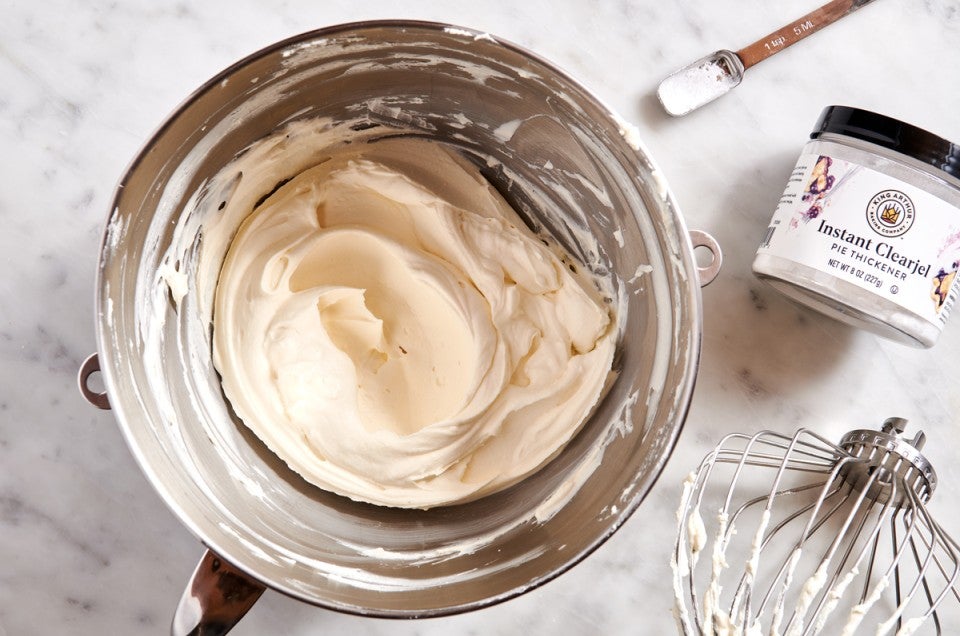Baking trials: What’s the best way to stabilize whipped cream?
From cornstarch to crème fraîche, here’s how to keep your whipped cream from weeping and deflating.


Most of us already know how to make whipped cream (but if you need a little help, check out this blog post). We’ve also covered how to make it in Mason jar and how to fix it when something’s gone wrong. But one of the more common questions we’re asked is how to stabilize whipped cream — that is, how to keep it longer, without it weeping or deflating. To determine the best method, I tested five stabilizers to find the very best one.
The main benefits of stabilizing whipped cream are to make it last longer and to prevent it from deflating and weeping. By its very nature, whipped cream is a pretty unstable thing: It’s mostly air that is held together by a network of fat molecules from the cream. This makes it a foam, and if you’ve dealt with foams before, you know that they don’t last long — think of a soufflé, for instance. It’s only a matter of minutes (or seconds!) before it deflates, and the billowy, fluffy texture yields to a slumped, unimpressive mush.
Whipped cream can suffer the same fate: If not stabilized, the network of fat molecules will collapse, losing the whipped-in air and returning the cream to its liquid state. To prevent a structural disaster and avoid a soupy, unstable mess, though, you can stabilize it by adding Instant ClearJel, cornstarch, or another dairy ingredient like mascarpone or crème fraîche.

Stabilizing whipped cream lends structural integrity to a stacked dessert. To achieve height in a dessert that is literally built on foam, you need that foam to be sturdy enough for the job. Stabilizing whipped cream also ensures easier portability and resistance to warm temperatures. Lastly, stabilizing whipped cream allows you to make it ahead of time.
By contrast, whipped cream that’s used as a ready-to-eat topping, such as garnishing a slice of pie, doesn’t need to be stabilized. As a topping, it’s not bearing the weight of other dessert components, and, since it will be eaten within a few minutes, time is not a concern.
When I think of stacked desserts, Napoleons immediately come to mind. Napoleons are stacks of crisp puff pastry that sandwich fluffy, creamy fillings between them, and if you fill them with unstabilized whipped cream, they’re more prone to toppling or sliding apart. Another stacked dessert is our Strawberry Mascarpone Tea Cake, with its thick layer of whipped cream holding up an entire sponge cake layer. Having a stabilized filling will keep it intact during transportation and help prevent it from collapsing in the heat at your next warm-weather gathering.

I tested five common ingredients used for stabilizing whipped cream to see which would hold up the best and the longest. In addition to whipped cream with no stabilizer at all, I tested versions with equal proportions of Instant ClearJel, cornstarch, crème fraîche, mascarpone, and plain yogurt.
To test duration, I let them all hang out in covered bowls in the refrigerator for five days. To test stability, I used the aforementioned Strawberry Mascarpone Tea Cake to see how the same lineup of stabilized creams would perform in a stacked cake that was refrigerated for three days.
When it came to the plain stabilized whipped cream, Instant ClearJel was the clear winner. After five days of refrigeration, the Instant ClearJel-stabilized whipped cream remained fluffy, aerated, and uniform in texture throughout. Tied for second place were crème fraîche and mascarpone. These both maintained quite a bit of aeration but had become slightly soupy in some places. Because both are pretty thick to begin with, my theory is that they naturally contribute structure and body to the whipped cream.
Yogurt performed next best, with similar results to the other dairy products, if just a little more deflated. Cornstarch came in fifth with weepy, gritty results. And of course, the whipped cream that had not been stabilized at all fared the worst, losing all its volume and becoming a fully liquid, sad mess.

All the stabilizers worked fine in the stacked cake set-up. It seems that the cake itself absorbed any weeping that the whipped cream may have undergone during refrigeration. So if you need to stabilize whipped cream used in a stacked cake or pastry that’s stored for three days or fewer, any of these options will work well.
Following the same weight ratio of confectioners’ sugar to stabilizer that we generally call for with Instant ClearJel (four parts sugar to one part Instant ClearJel), you can swap in any of these stabilizers for sturdy, stacked, sliceable cream-filled cakes. The caveat is that they may bring textural or flavor additions that Instant ClearJel would not. Cornstarch tends to impart a bit of chalkiness, while crème fraîche and mascarpone each bring a mild milky flavor, and plain yogurt offers a (perhaps unwanted) tang.
The short answer is: Follow any recipe as written for the best results. It will have been tested with your success in mind and has proper portions and ingredients already determined. If you’re making whipped cream to serve alongside your favorite dessert, it’s best to make it just prior to serving (in which case there’s no need to stabilize), but if you must make it ahead of time, you’ll get the best results by stabilizing your whipped cream with Instant ClearJel.
If you’re making a stacked dessert with whipped cream, and the recipe calls for a particular stabilizer, it’s best to use what is recommended. If you must make a substitution, Instant ClearJel is still the best choice, but cornstarch, crème fraîche, mascarpone, and plain yogurt will all work well too.
Learn more about Instant ClearJel, how to use it, and why bakers swear by it.
Cover photo by Danielle Sykes; food styling by Kaitlin Wayne.


